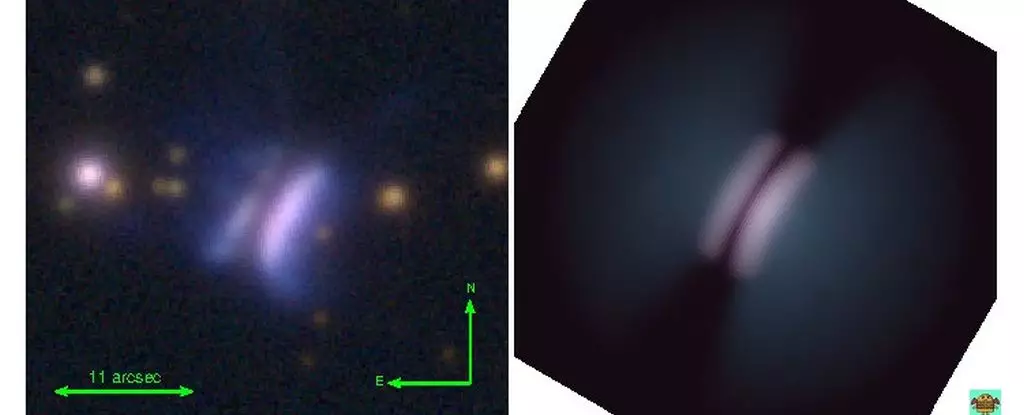In the vast expanse of space, a team of astronomers led by Ciprian Berghea of the US Naval Observatory has discovered a captivating object named Dracula’s Chivito. This peculiar celestial being has earned its nickname due to its uncanny resemblance to the meat-laden Uruguayan national dish. Dracula’s Chivito is not, however, an actual sandwich but rather a baby star shrouded by a dense disk of dust and gas. When viewed from an edge-on perspective, this arrangement vaguely resembles a sandwich if one squints their eyes. Yet, the reasons for the peculiar name extend beyond its appearance. A similarly-shaped object observed in the Milky Way in 1985 was dubbed Gomez’s Hamburger and was later identified as a baby star situated approximately 900 light-years away in 2008. Notably, Dracula’s Chivito shares striking similarities with Gomez’s Hamburger. Both are located at a similar distance of around 980 light-years and exhibit a comparable orientation, where the disk of dust and gas intersects the star’s light, reminiscent of the filling in a sandwich. The study of these extraordinary yet rare objects may provide valuable insights into a class of newly formed stars that remains relatively unexplored.
An intriguing aspect of both Dracula’s Chivito and Gomez’s Hamburger is their absence from the typical environments known as stellar nurseries, where new stars are born amidst a rich abundance of materials. Instead, these isolated stars seem to inhabit relatively empty space, leaving few clues to unravel the enigma behind their formation. Our understanding of the stellar birth process has expanded significantly thanks to numerous radio observations. Typically, stars begin their lives as dense clumps within molecular gas clouds that collapse under their own gravitational force, sparking the formation of a protostar. As the protostar spins, it grows in size, while the surrounding cloud material organizes itself into a swirling disk, fueling the star’s growth.
The fact that Dracula’s Chivito and Gomez’s Hamburger do not appear to be associated with any nearby star-forming regions or clusters poses a perplexing mystery. Nonetheless, their remarkable resemblance may hold some clues to their origins. Taking a closer look at Dracula’s Chivito, Berghea and his colleagues have determined that the central star is likely a hot, Herbig Ae-type star, with temperatures reaching approximately 8,000 Kelvin (7,727 Celsius or 13,940 Fahrenheit). The disk surrounding the star spans an impressive radius of about 1,650 astronomical units, containing material with a mass of roughly 0.2 times that of our Sun. While these properties align closely with those of Gomez’s Hamburger, Dracula’s Chivito possesses an intriguing addition – two protruding filaments extending from the “buns.” These filaments, reminiscent of fangs, led the scientists to conclude that they represent a dissipating envelope encompassing the star. The presence of this thin envelope provides crucial insight into the star’s formation stage. Young stars tend to emit powerful winds and jets that disperse the excess material surrounding them. Thus, the existence of such an envelope indicates that Dracula’s Chivito is still in its infancy.
Read More: The Impact of Passing Stars on Earth’s Climate
This fascinating discovery not only offers an unprecedented opportunity to study the vertical structure of the star formation process but also raises the possibility that isolated baby stars may be more prevalent than previously believed. However, numerous questions persist regarding the origins and existence of these solitary stars in the depths of space. The quest to find more instances of these remarkable objects could hold the key to unraveling these captivating mysteries and shedding light on the formation of stars in the universe.
Dracula’s Chivito, with its sandwich-like appearance, beckons us to delve into the depths of the Milky Way. By studying this enigmatic baby star and its counterpart, Gomez’s Hamburger, astronomers aim to gain a deeper understanding of the mysterious world of stellar birth. These objects defy conventional expectations, floating in relatively empty space, far from the nurturing environment of stellar nurseries. Their rarity and uniqueness make them invaluable from a scientific standpoint, offering a window into the unknown aspects of the star formation process. As we continue to explore the universe, the search for further instances of isolated baby stars promises to be an exciting and enlightening endeavor.


Leave a Reply